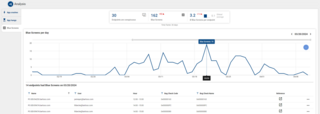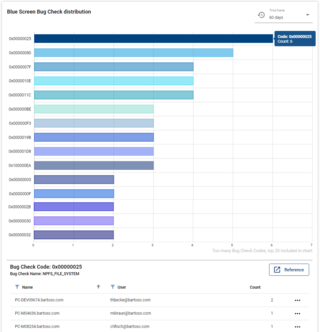
Do your systems "go blue"?
Whether it’s the medical term “Code Blue,” the classic “BSOD,” or, as we say in Germany, “Going blue,” the color blue generally means bad news for IT admins. Sudden, unexpected system crashes often occur at the most inopportune moments and result in expensive, time-consuming downtime. With baramundi perform2work, you can get those unwanted “blue screeners” under control.
In short
- Digital Employee Experience (DEX) management solutions such as baramundi perform2work provide rapid detection of blue screen errors and enable proactive problem-solving.
- Downtime decreases and user experiences improve.
- Blue screens also can indicate possible security threats, which makes rapid detection of these errors particularly valuable.
What is blue screen detection?
Just as “Code Blue” emergencies in hospitals mean that a patient is in a critical, life-threatening condition, references to the color blue in IT often signal serious, urgent
endpoint problems that are sudden, unpredictable and difficult to diagnose. When a system shows the “blue screen of death” (BSOD) or is “Going blue” – a German expression for
playing hooky or skipping work – it can involve anything from hardware faults to security vulnerabilities to software bugs.
However, blues screen crashes are a problem not only for IT teams, but also for end users. If employees encounter a blue screen once or even several times, frustration increases,
productivity decreases, and support tickets get escalated. These are situations that need to be analyzed and resolved quickly – or even better – avoided.
Digital Employee Experience (DEX) solutions help both IT admins and end users recover from this nightmare. The
DEX solution from baramundi – baramundi perform2work – is designed to detect these critical errors and provide detailed
diagnostic information to uncover the underlying causes.
The advantages of blue screen detection
1. Deal with problems proactively:
- Quick diagnosis: automatic recording of error codes and system information in the event of a blue screen crash.
- Cause analysis: Does a blue screen error code occur on one or several endpoints? In the latter case, eliminating the cause will have a much greater positive impact.
2. Increase system resiliency:
- Reduced system downtime: Early detection and treatment of potential problems can prevent major outages.
3. Improve user experiences:
- Stable working environments: Fewer disruptions due to system errors mean more productive and satisfied users.
- Faster troubleshooting: Shorter response and resolution times improve overall user satisfaction and IT efficiency.
4. Increase IT security:
- Recognize security threats: Blue screens can also be caused by security vulnerabilities. If you recognize them early, you can reduce risks.
- Preventive measures: Immediate responses to detected threats prevent data loss and other security issues.
Blue screens and IT security?
One thing is clear: blue screens are not only a sign of possible hardware or software errors but can also indicate more serious security threats. An unexpected system crash may be the result of a successful malware or ransomware attack, especially if it occurs repeatedly. Cyber attackers use various techniques that lead to system crashes to exploit security vulnerabilities or bypass existing protection measures.
Risks from blue screens in relation to IT security
1. Hidden exploits:
- A blue screen may indicate that an exploit has attempted to gain higher system privileges and failed, resulting in a system crash.
- Such incidents provide important clues to hidden security vulnerabilities that remain undetected without in-depth analysis.
2. Injected malware:
- Certain types of malware are programmed to crash systems, either to distract from other malicious activity or to install additional components after a reboot.
- A blue screen can be the first indication of an infection, especially if it occurs shortly after opening a file or running an application.
3. Data integrity and availability:
- System crashes may lead to data corruption, especially if files were open or being written at the time of the crash.
- Repeated blue screens are also a sign that an attacker is trying to interrupt backups or data recovery processes.
Stability + safety = an increasingly important requirement
IT admins are the heroes for end users in an increasingly digital world as the dependency on stable and secure IT infrastructure continues to grow. The blue screen
detection feature in baramundi perform2work offers an important added value and decisive advantage for IT teams because it is specifically designed to maximize uptime and minimize
critical system failures.
A blue screen is often more than just a technical annoyance - it is a warning of underlying, imminent or active security risks. Take the opportunity to strengthen your systems and
make your employees' digital experiences frustration-free and secure.




